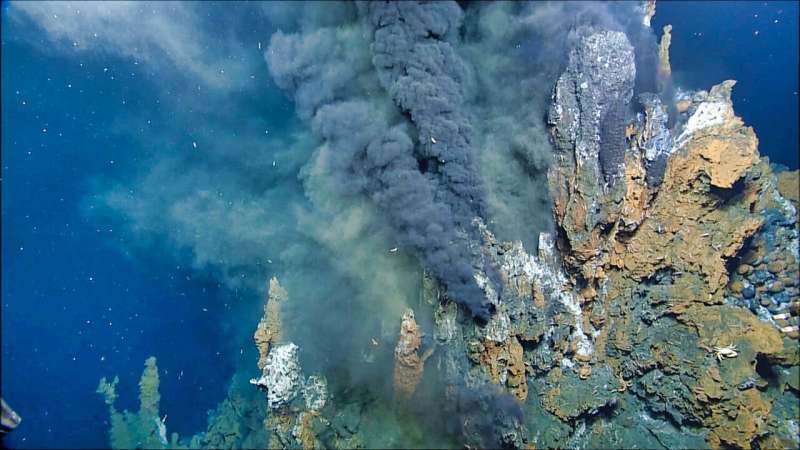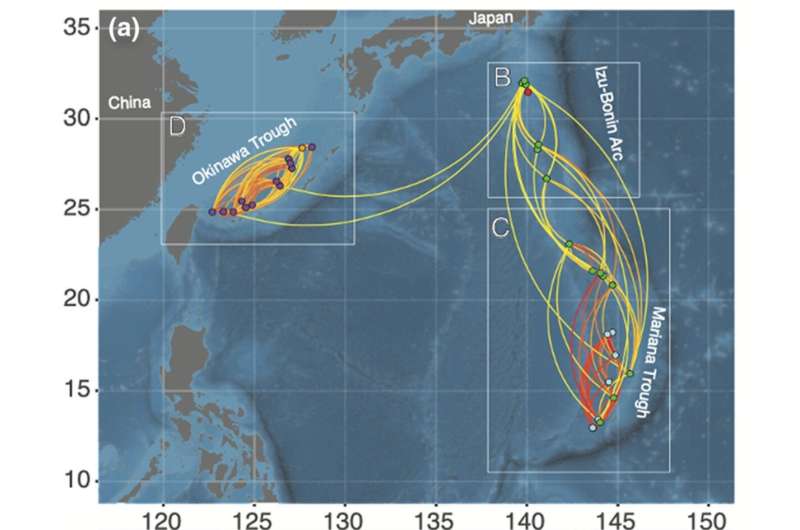This article has been reviewed according to Science X's editorial process and policies. Editors have highlighted the following attributes while ensuring the content's credibility:
fact-checked
peer-reviewed publication
trusted source
proofread
Mining at key hydrothermal vents could endanger species at distant sites

Destruction of key hydrothermal vents by deep-sea mining could have knock-on impacts for vent fields hundreds of kilometers away, suggests a new paper published in Ecology and Evolution.
The study, which was conducted by scientists from the Okinawa Institute of Science and Technology (OIST), in collaboration with the Japan Agency for Marine-Earth Science and Technology (JAMSTEC), and the University of Victoria, British Columbia, has revealed how different vents in the Northwest Pacific are connected to each other. The research also identifies key vents that are particularly important for maintaining connectivity, which need to be prioritized for conservation.
"These results could provide a powerful tool for helping policy makers and the mining companies decide which sites should be protected from mining," said Otis Brunner, first author and Ph.D. student in the OIST Marine Biophysics Unit, led by Professor Satoshi Mitarai.
Hydrothermal vents are extreme deep-sea environments that exist in geologically active areas on the seafloor. These vents, which are like underwater geysers, spew hot water filled with minerals out from cracks in the seabed. And despite the intense heat and pressure, these vent systems teem with strange and unique life. These creatures around these vents, such as crabs, shrimps and worms, all rely on bacteria, which uses chemical energy from the vent to make biomass.
The chemical-rich waters that sustain life also make these environments an attractive target for the emerging industry of deep-sea mining. When the chemicals that come out of the earth's crust meet the cold seawater, they precipitate and create chimney-like deposits on the seabed, called sea floor massive sulfides.
"These chimneys contain a high quality and quantity of gold, silver, copper and other rare earth minerals that we need to feed our technology-hungry society," said Brunner.
However, extracting these resources destroys the creatures living on that chimney, and severely impacts those on nearby chimneys within the same hydrothermal vent site.
"Each hydrothermal vent often hosts some endemic species, meaning they only live there. So if you remove or severely damage their ecosystem, not only have you lost those animals, but you've lost that species entirely," said Brunner.
And now, Brunner's research shows that the damage to hydrothermal vent ecosystems is also unlikely to be limited to just one single vent site, but could impact other vent sites hundreds of kilometers away.

Although hydrothermal vents seem isolated from each other, many hydrothermal vent species can actually disperse from one vent to another while in the larval stage, assisted by the ocean currents. If they manage to reach another vent, and the conditions at the new vent are similar (hydrothermal vents can differ significantly in depth, chemical composition of the vent fluid, intensity and heat), then the creatures can settle and mature into adulthood.
This means that if a species population is wiped out at one hydrothermal vent, then the population of the same species at another hydrothermal vent, where the larval used to disperse to, will also be threatened.
In his study, Brunner looked at vent sites within three sub-regions of the Northwest Pacific—the Okinawa Trough, the Izu-Bonin Arc and the Mariana Trough. He inferred how connected each vent site was to the others by comparing how many species the vent sites had in common.
By creating networks from the species data, Brunner and his colleagues identified which vent sites act as important hubs within each sub-region.
Two vent sites, Sakai and North Knoll Iheya Ridge, were found to be the most important for maintaining connectivity in the Okinawa Trough sub-region and should be prioritized for conservation.
"Unfortunately, the Sakai and North Knoll Iheya vent sites are situated in the central region of the Okinawa Trough, an area of particular interest for mining," said Brunner. "But any disturbance to these two sites would have particularly strong impacts on all the species at hydrothermal events across Japan."
For the Izu-Bonin Arc and Mariana Trench, Nikko volcano and Alice Springs were the most important hub, respectively. There is no current interest in deep-sea mining at these sites.
The study also identified pathways of connectivity linking both the Okinawa Trough and the Mariana Trench to the Izu-Bonin Arc. However, these linkages only occurred across a small number of hydrothermal vents, including the Daisan-Kume Knoll in the Okinawa Trough, situated within an area of mining interest. Mining activity here could cause a collapse in the network across the Northwest Pacific region.
Of final note were two outlier vent sites, the Sumisu Caldera and the Minami-Ensei Knoll, that showed low connectivity to any other vents in the region. These vents have very different features to other vents in the Northwest Pacific, with many creatures endemic to these sites.
"Mining at these vents would be less likely to impact others, but they are very unique and fragile ecosystems that also need to be conserved," said Brunner.
More information: Otis Brunner et al, Species assemblage networks identify regional connectivity pathways among hydrothermal vents in the Northwest Pacific, Ecology and Evolution (2022). DOI: 10.1002/ece3.9612
Journal information: Ecology and Evolution
Provided by Okinawa Institute of Science and Technology


















